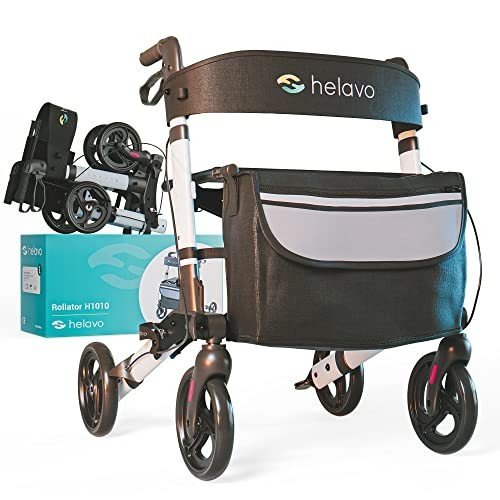
Collapsible Rollator
Add a review FollowOverview
-
Founded Date June 3, 1960
-
Sectors test
-
Posted Jobs 0
-
Viewed 15
Company Description
See What Rollator With Storage Tricks The Celebs Are Making Use Of
Rollator with Storage: A Comprehensive Guide for Independent Mobility
Rollators are mobility aids developed to help people with walking troubles while promoting self-reliance and safety. Unlike conventional walkers, rollators come geared up with wheels for effortless navigation, making them an essential tool for numerous elderly and disabled people. Among the essential functions that enhance the performance of rollators is storage. This short article checks out rollators with integrated storage options, highlighting their benefits, types, and crucial factors to consider when choosing the ideal model.
Comprehending Rollators
What is a Rollator?
A rollator is a wheeled walker that supplies assistance for individuals who may have problem with balance or endurance. Typically, rollators are developed with the following functions:
- Wheels: Rollators are geared up with either two or four wheels, enabling smooth maneuverability.
- Hand Brakes: Most have hand brakes for included safety, allowing users to control their speed.
- Seat: Many designs include a built-in seat, offering a resting point when required.
- Storage: Rollators often feature baskets or bags for bring individual items like water bottles, groceries, or medical products.
Benefits of Using a Rollator with Storage
The inclusion of storage choices in rollators brings a number of advantages:
- Convenience: Users can quickly carry personal belongings, decreasing the requirement for additional support.
- Independence: Having access to important items while being mobile empowers people to preserve their independence in various environments, such as grocery stores, parks, or homes.
- Safety: By firmly storing items, users can more confidently browse their environments without the threat of dropping valuable products.
- Comfort: Having a seat for resting allows users to take breaks when required, even more improving mobility.
Types of Rollators with Storage
Numerous types of rollators come geared up with storage services:
| Rollator Type | Description | Appropriate for |
|---|---|---|
| Requirement Rollator | Generally includes 4 wheels and a sturdy frame. Storage choices, like an integrated bag or basket, are frequently consisted of. | General use, outdoors |
| Compact Rollator | A smaller variation that folds easily for transportation. While these models typically have actually limited storage, many still include minimal functionality. | Travelers and tight areas |
| Sturdy Rollator | Developed for bigger individuals, these rollators typically have much better storage capability. | Bigger users, stability needs |
| Rollator with Seat | Functions a built-in seat for resting. Storage options differ, typically including baskets or shopping bags. | Those needing routine breaks |
| Walker-Carrier Combo | Acts as both a rollator and a lightweight cart, ideal for shopping journeys. | Grocery shopping, outdoor use |
Choosing the Right Rollator with Storage
When selecting a rollator with storage, numerous aspects should be considered to guarantee that it meets specific needs.
Secret Features to Assess
- Weight Capacity: Always examine the weight limit of the rollator to ensure safety and usability.
- Size and Foldability: Consider how the rollator suits your living area and whether it can be quickly stored or carried.
- Storage Capacity: Assess the size and availability of storage compartments. Look for alternatives that allow for secure storage without frustrating the user with complexity.
- Adjustable Handles: Ensure that the handles can be gotten used to the appropriate height to improve comfort and ergonomics.
- Braking System: A trusted braking system is necessary. Guarantee the brakes are simple to engage and disengage.
- Wheel Size and Type: Larger wheels can navigate rougher terrain, while smaller sized ones may be preferable for flat surfaces.
Additional Considerations
- Devices: Many rollators have optional accessories, such as cup holders or seat cushions, to enhance user experience.
- Guarantee and Support: Investigate whether the producer provides a warranty for flaws or damages.
- User Reviews: Online consumer evaluations can offer valuable insights into efficiency and fulfillment.
Maintenance and Care of Rollators
To make sure longevity and optimal performance, regular maintenance is important. Users ought to consider the following practices:
- Regular Cleaning: Wipe down the frame and parts to avoid rust and keep health.
- Inspect Brakes: Ensure that the brakes are functioning appropriately and adjust them as required.
- Examine Wheels: Regularly look for any debris captured in the wheels or indications of wear and tear.
- Tighten Hardware: Periodically inspect and tighten up screws or bolts to preserve safety.
Often Asked Questions (FAQs)
1. How do I choose the right size rollator for me?
Choosing the best size includes examining your height and weight, in addition to checking handle height modifications to guarantee that it appropriates for your stature.
2. Can I use a rollator on irregular surface?
Yes, some rollators are developed with larger wheels and shock-absorbing systems that make them more ideal for unequal terrain. It’s important to check the specifications.
3. Is it simple to fold a rollator for transportation?
The majority of modern rollators are developed to be easily foldable. Try to find guidelines in the user manual that accompany your chosen design.
4. Just how much weight can a normal rollator support?
A lot of basic rollators support in between 250 to 350 pounds; however, heavy-duty designs can support greater weights.

5. Can I add accessories to my rollator?
Yes, numerous rollators come with the option of adding accessories like cup holders, trays, and bags to boost performance.
In summary, a rollator with storage is an important mobility aid that empowers individuals while offering them with the benefit of transferring vital items. By comprehending the different types, crucial features, and maintenance requirements, users can confidently pick the right rollator that fits their way of life, promoting independence and convenience in day-to-day activities. As mobility aids continue to evolve, they end up being progressively important for improving the lifestyle for elderly and disabled people.